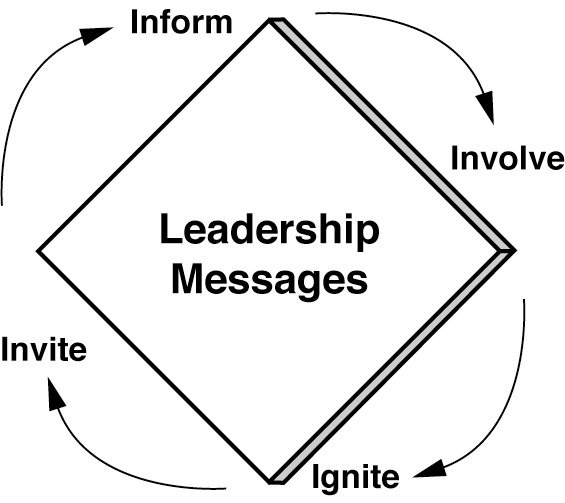Westside Toastmasters is located in Los Angeles and Santa Monica, California - Westside Toastmasters on Meetup
What a Leadership Message Does: The Four I's
Leadership messages must communicate information as well as open the door for participation by the listener. As such, the leadership message must do these four things (see Figure 3-2):[2]
Inform people of what the issues are and what they need to do. Leaders owe their people an explanation of the situation, whether the news is good or bad. Good examples of leaders who kept their people informed are Jack Welch of General Electric and Rich Teerlink of Harley- Davidson; both of these CEOs let people know what was going on in the business as well as attending and participating in events where stakeholders and other people voiced their ideas. Both men also spent time listening to customers, which meant that they were personally informed about issues, and that when it came time to communicate internally, they did so from a credible platform of knowledge. Also keep in mind that even when there is no news, leaders need to be seen and heard frequently. Absence in this case does not make the heart grow fonder, it gives rise to gossip.
Involve others by soliciting their input. Herb Kelleher, founder of Southwest Airlines, was a master of getting other people involved. By traveling around on his airline, he met and mingled with employees at all levels of the organization, from executives to ticket agents and baggage handlers. His openness shattered the imaginary barrier between boss and employee, and in so doing invited people to raise issues and offer suggestions. Add to this the fact that Southwest Airlines is employee owned, and you have a successful model for involvement because employees have a stake in the enterprise.
Ignite people's imaginations about what they can do to make things better for themselves and their organizations. Imagination is a powerful mental tool. Consider the example of Mohandas Gandhi in the independence movement in India. Gandhi's words and example, coupled with the charisma that sprang from his commitment and simplicity, rallied a nation to think about the possibility of becoming independent from Britain. While many thousands of leaders in every region of the subcontinent made separation possible, it was Gandhi who lit the flame and stoked it by words and example.
Invite people to participate in the enterprise, whether it be the fulfillment of a goal or the transformation of a culture. Leaders who talk about what people can do for themselves and by themselves are leaders who understand their role as inspiring action or change. Joe Torre never batted, fielded, or pitched for his Yankee championship teams, yet he was the one who invited superstars and other players to play together as a team in order to win. His invitation made players of all abilities feel that they could contribute, and as a result, they did. Other successful coaches do the same thing, and in the process create win-win situations: a win on the scoreboard and a win for the collective psyche of the team.
All four elements need not be apparent in every message. Sometimes the leader's message is simply an update. Other times it's a call to action or an invitation to do something. But over the course of a leader's tenure, the success of leadership communications depends upon including these four elements over and over again.
When a leader informs his or her people, involves others in the effort, ignites ideas about what is to be done, and invites people to participate in the process, that leader gains support for his or her ideas and makes the process of achieving results possible. Also, as with all strong leadership messages, the leader makes it possible to build greater levels of trust, the bond upon which all leadership must be grounded.
[2] Synopsizing four points of a communications model (empathize, engage, educate, enlist) from James Wanless, Intuition @ Work & at Home and at Play.




